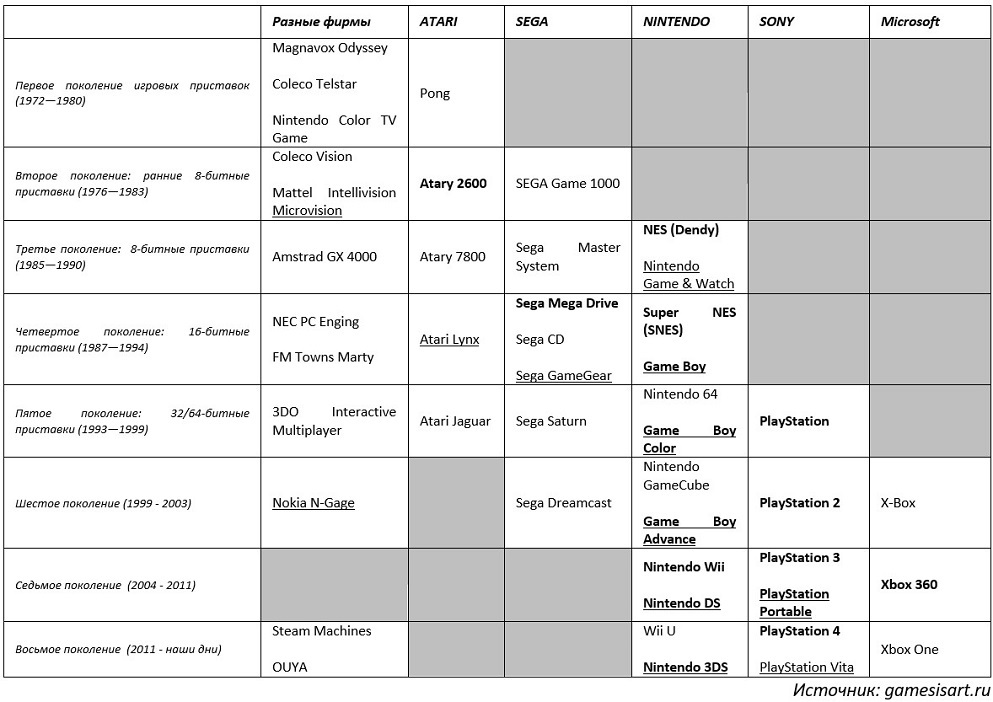A brief history of the gaming industry by platform
Back in 1978, the commercially successful game Space Invaders strongly motivated large investors to pay attention to the gaming industry. This video game was released in Japan on a platform that we know as arcade machines. The game became so popular that it caused a shortage of coins in the country, which were required in order to play it. From Japan, the game quickly found its distribution in America, where 60,000 units were sold in 2 years. They stood in all bars, bowling clubs and cinemas. Thanks to Space Invaders, the development boom of arcade vehicles began, which became the first step in the evolution of the game industry. In 1979, this was a real breakthrough: the American distributor of the game Belly Midway tripled the slot machine market in the United States, bringing sales to 1.33 billion dollars a year. Many well-known computer games first appeared on gaming machines and were later ported to other platforms. For example, Pac-Man, Street Fighter, Killer Instinct. Under the cut I offer you a small insight into the history of the evolution of platforms in the gaming industry .

Together with gaming machines, games evolved on the platform of gaming consoles . And although the history of consoles began in 1972 with the release of the world's first home gaming console Magnavox Odyssey, a breakthrough in this direction begins in 1977, when the Atari 2600 gaming console goes on sale. Thanks to Atari's investment, the popularization of computer and video games is reaching a new level . There are new major players who want to take a warm place in the video game market. In addition to Atari, Sega, Nintendo, Sony and Microsoft are the largest ones.

Another major gaming platform "from ancient times" became personal computers . The first games on them appeared in the 1960s. These were text-based adventure games, in which communication between the player and the computer was carried out by entering commands via the keyboard. The further evolution of games is closely related to the growth of productivity and capabilities of computer equipment. This includes the popularization of computer mice as a human-computer interaction interface, the emergence of sound cards that enable the reproduction of full-fledged sounds, and the annual improvement in the quality of the displayed image, and of course the development of computer networks resulting in the emergence of the Internet. With the evolution of networks, the usual generation of single-player client games is being replaced by a new generation of games, giving the opportunity to play together with other players. The very first online game was made in text form and launched on TelNet in 1978. The developers of this game were Richard Bartle and Roy Trabshaw. They called their creation Multi-user Dungeon, abbreviated MUD. In the future, this abbreviation was used as a classification for multiplayer online games, where everything is displayed as text. MUD is the source of all virtual worlds that we know today.
')

With the advent of the Internet in addition to the familiar to all single-player games come online projects: client and browser. In the late 90s, the growing speeds of Internet access make it possible for the browser to become an independent gaming platform . It acts as an operating shell for games, allowing you to play without installing additional programs. Developing gaming markets for a long time had a high proportion of browser games, which was associated with a lag in hardware - meaning China, Russia.
In the middle of the two thousandth comes the exponential growth of social networks, which are becoming a new way of communication between people. Now game developers simply cannot ignore the browser platform and inside it there is a separate sub-platform and games for it, which are now called social . Then it seemed to many that this was a huge breakthrough in the gaming industry. A huge number of developers went to social games, the annual growth rate exceeded 200% simply because it was an innovation and there was not even a market before. However, the saturation came pretty quickly. In place of low-quality gaming products produced at a breakneck pace in order to occupy the market, high-quality games with good graphics and serious gameplay come.
The next round of development of the gaming industry was due to the tremendous growth of the popularity of mobile phones , which became a new platform for communication of people and a new platform for the distribution of games. Java games that were on mobile phones did not seriously compete with browser, client, or social games. However, since the end of the first decade of the 2000s, the emergence of smartphones, under which it was possible to develop powerful projects, has opened up the mobile gaming market for the industry. In general, the mobile platform is being implemented now through two types of devices: smartphones and tablets. But since the operating systems, specifications and ways of delivering games to the consumer on these devices are almost identical, developers rarely divide them into different platforms. It is mobile games that many currently consider to be a promising market capable of generating maximum profits at a low threshold of entry. On our program, " Management of online gaming projects, " most of the listeners do exactly mobile games, and in second place is PC games under Steam.

The history of the development of gaming platforms shows that with the development of technology, the process of the emergence of innovative platforms for games is accelerating. Some of them "blow up" the market and crowd out the old ones, some do not gain explosive growth but occupy their niche - for example, Smart TV, smart watches, games on airplanes, games on vapes, etc. It is quite likely that in the coming years the market of mobile games will be superseded from the gaming industry trend by a more advanced human-computer interaction technology. This can be either a virtual or augmented reality in the current implementation, or a virtual reality with full immersion. Time will tell!

Together with gaming machines, games evolved on the platform of gaming consoles . And although the history of consoles began in 1972 with the release of the world's first home gaming console Magnavox Odyssey, a breakthrough in this direction begins in 1977, when the Atari 2600 gaming console goes on sale. Thanks to Atari's investment, the popularization of computer and video games is reaching a new level . There are new major players who want to take a warm place in the video game market. In addition to Atari, Sega, Nintendo, Sony and Microsoft are the largest ones.

Another major gaming platform "from ancient times" became personal computers . The first games on them appeared in the 1960s. These were text-based adventure games, in which communication between the player and the computer was carried out by entering commands via the keyboard. The further evolution of games is closely related to the growth of productivity and capabilities of computer equipment. This includes the popularization of computer mice as a human-computer interaction interface, the emergence of sound cards that enable the reproduction of full-fledged sounds, and the annual improvement in the quality of the displayed image, and of course the development of computer networks resulting in the emergence of the Internet. With the evolution of networks, the usual generation of single-player client games is being replaced by a new generation of games, giving the opportunity to play together with other players. The very first online game was made in text form and launched on TelNet in 1978. The developers of this game were Richard Bartle and Roy Trabshaw. They called their creation Multi-user Dungeon, abbreviated MUD. In the future, this abbreviation was used as a classification for multiplayer online games, where everything is displayed as text. MUD is the source of all virtual worlds that we know today.
')

With the advent of the Internet in addition to the familiar to all single-player games come online projects: client and browser. In the late 90s, the growing speeds of Internet access make it possible for the browser to become an independent gaming platform . It acts as an operating shell for games, allowing you to play without installing additional programs. Developing gaming markets for a long time had a high proportion of browser games, which was associated with a lag in hardware - meaning China, Russia.
In the middle of the two thousandth comes the exponential growth of social networks, which are becoming a new way of communication between people. Now game developers simply cannot ignore the browser platform and inside it there is a separate sub-platform and games for it, which are now called social . Then it seemed to many that this was a huge breakthrough in the gaming industry. A huge number of developers went to social games, the annual growth rate exceeded 200% simply because it was an innovation and there was not even a market before. However, the saturation came pretty quickly. In place of low-quality gaming products produced at a breakneck pace in order to occupy the market, high-quality games with good graphics and serious gameplay come.
The next round of development of the gaming industry was due to the tremendous growth of the popularity of mobile phones , which became a new platform for communication of people and a new platform for the distribution of games. Java games that were on mobile phones did not seriously compete with browser, client, or social games. However, since the end of the first decade of the 2000s, the emergence of smartphones, under which it was possible to develop powerful projects, has opened up the mobile gaming market for the industry. In general, the mobile platform is being implemented now through two types of devices: smartphones and tablets. But since the operating systems, specifications and ways of delivering games to the consumer on these devices are almost identical, developers rarely divide them into different platforms. It is mobile games that many currently consider to be a promising market capable of generating maximum profits at a low threshold of entry. On our program, " Management of online gaming projects, " most of the listeners do exactly mobile games, and in second place is PC games under Steam.

The history of the development of gaming platforms shows that with the development of technology, the process of the emergence of innovative platforms for games is accelerating. Some of them "blow up" the market and crowd out the old ones, some do not gain explosive growth but occupy their niche - for example, Smart TV, smart watches, games on airplanes, games on vapes, etc. It is quite likely that in the coming years the market of mobile games will be superseded from the gaming industry trend by a more advanced human-computer interaction technology. This can be either a virtual or augmented reality in the current implementation, or a virtual reality with full immersion. Time will tell!
Source: https://habr.com/ru/post/312884/
All Articles